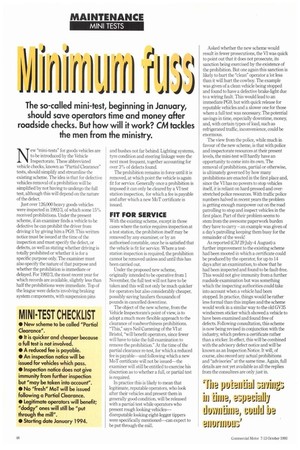i L ir f F JJ N ew "mini-tests" for goods vehicles are
Page 50

If you've noticed an error in this article please click here to report it so we can fix it.
to be introduced by the Vehicle Inspectorate. These abbreviated vehicle checks, known as "Partial Clearance" tests, should simplify and streamline the existing scheme. The idea is that for defective vehicles removal of a prohibition will be simplified by not having to undergo the full test, although this will depend on the nature of the defect.
Just over 126,000 heavy goods vehicles were inspected in 1992/3, of which some 15% received prohibitions. Under the present scheme, if an examiner finds a vehicle to be defective he can prohibit the driver from driving it by giving him a PG9. This written notice must be issued at the time of the inspection and must specify the defect, or defects, as well as stating whether driving is totally prohibited or whether it is for a specific purpose only. The examiner must also specify the nature of that purpose and whether the prohibition is immediate or delayed. For 1992/3, the most recent year for which records are available, slightly less than half the prohibitions were immediate. Top of the league were defects involving braking system components, with suspension pins and bushes not far behind. Lighting systems, tyre condition and steering linkage were the next most frequent, together accounting for over 3% of defects found.
The prohibition remains in force until it is removed, at which point the vehicle is again fit for service. Generally once a prohibition is imposed it can only be cleared by a VI test station inspection, for which a fee is payable and after which a new MoT certificate is issued.
FIT FOR SERVICE
With the existing scheme, except in those cases where the notice requires inspection at a test station, the prohibition itself may be removed by any examiner, or by an authorised constable, once he is satisfied that the vehicle is fit for service. Where a teststation inspection is required, the prohibition cannot be removed unless and until this has been carried out.
Under the proposed new scheme, originally intended to be operative from 1 November, the full test will not have to be taken and this will not only be much quicker for operators but also considerably cheaper, possibly saving hauliers thousands of pounds in cancelled downtime.
The object of the new scheme, from the Vehicle Inspectorate's point of view, is to adopt a much more flexible approach to the clearance of roadworthiness prohibitions. "This," says Neil Cumming of the VI at Bristol, "will benefit operators, since fewer will have to take the full examination to remove the prohibition." At the time of the partial clearance re-test, for which a reduced fee is payable—and following which a new MoT certificate will not be issued—the examiner will still be entitled to exercise his discretion as to whether a full, or partial test is required.
In practice this is likely to mean that legitimate, reputable operators, who look after their vehicles and present them in generally good condition, will be released with a partial test while operators who present rough looking vehicles— disreputable looking eight-legger tippers were specifically mentioned—can expect to be put through the mill,
Asked whether the new scheme would result in fewer prosecutions, the VI was quick to point out that it does not prosecute, its sanction being exercised by the existence of the prohibition. But one again this sanction is likely to hurt the "clean" operator a lot less than it will hurt the cowboy. The example was given of a clean vehicle being stopped and found to have a defective brake-light due to a wiring fault. This would lead to an immediate PG9, but with quick release for reputable vehicles and a slower one for those where a full test was necessary. The potential savings in time, especially downtime, money, and, with certain types of load, such as refrigerated traffic, inconvenience, could be enormous.
The view from the police, while much in favour of the new scheme, is that with police and inspectorate resources at their present levels, the mini-test will hardly have an opportunity to come into its own. The removal of prohibitions, partial or otherwise, is ultimately governed by how many prohibitions are enacted in the first place and, since the VI has no powers to stop vehicles itself, it is reliant on hard-pressed and overstretched police resources. With traffic police numbers halved in recent years the problem is getting enough manpower out on the road patrolling to stop and inspect vehicles in the first place. Part of their problem seems to stem from the awesome paperwork burden they have to carry – an example was given of a day's patrolling keeping them busy for the remainder of the week!
As reported (CM 29 July -4 August) a further improvement to the existing scheme had been mooted in which a certificate could be produced by the operator, for up to 14 days after an examination, to show that he had been inspected and found to be fault-free. This would not give immunity from a further roadside examination but was something which the inspecting authorities could take into account when a vehicle had been stopped. In practice, things would be rather less formal than this implies and the scheme would work in a similar way to the old GV35 windscreen sticker which showed a vehicle to have been examined and found free of defects. Following consultation, this scheme is now being revised in conjunction with the industry, which prefers a certificate rather than a sticker. In effect, this will be combined with the advisory defect notice and will be known as an Inspection Notice. It will, of course, also record any actual prohibitions and "advisories" at the same time. Again, full details are not yet available as all the replies from the consultees are only just in.




























































































